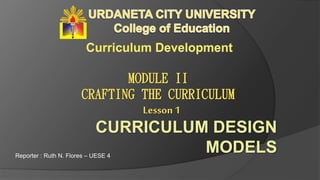
Curriculum Design Models
- 1. MODULE II CRAFTING THE CURRICULUM Lesson 1 Reporter : Ruth N. Flores – UESE 4
- 2. As a TEACHER, one has to be a: – curriculum designer – curriculum implementer – curriculum evaluator I N T R O D U C T I O N
- 3. HORIZONTAL VERTICAL the direction of the curriculum elements is sideways. the sequence of the curriculum elements follow a vertical design
- 4. HORIZON TAL ARRANGEMENT INTERELATE Ex. #1 EX. #2
- 6. This model focuses on the content of the curriculum. The subject centered design corresponds mostly of the textbook, written for the specific subject. Henry Morrison and William Harris are the few curricularist who were firm believers of this design. In this instance, schools divide the school hours to different subjects such as reading, grammar, literature, mathematics, science, history and geography. In the Philippines, our curricula in any level is also divided in different subjects or course. Most of schools using this kind of structure aim for excellence in the subject matter content. SUBJECT-CENTERED DESIGNMODEL
- 7. SUBJECT DESIGN oldest and so far the most familiar design for teachers, parents and laymen. Examples of Subject-centered Design Advantages Disadvantages •Easy to deliver •Complimentary books are written •Support instructional materials are commercially available •Teachers are familiar with the format •Learning is compartmentalized •Stresses so much the content that it forgets the student’s natural tendencies, interests and experiences
- 8. DISCIPLINE DESIGN Focuses on academic disciplines DISCIPLINE – refers to specific knowledge learned through a method which the scholars use to study a specific content of their field.
- 9. Often use in college, but not in elementary or secondary levels
- 10. The discipline design engages the students so they can analyze the curriculum and draw conclusions. It helps students to master the content area and in turn increase independent learning. According to Bruner, the discipline design clarifies the relationship between beginning knowledge and advanced knowledge. This will allow the students to gain meaning and advance through the content.
- 11. CORRELATION DESIGN Comes from core, correlated curriculum design that links separate subject designs in order to reduce fragmentation Subjects are related to one another but each subject maintains its identity.
- 12. BROAD FIELD DESIGN/INTERDISCIPLINARY A variation of the subject-centered design This design was made to prevent the compartmentalization of subjects and integrate the contents that are related to each other
- 14. LEARNER-CENTERED DESIGN “Learner is the center of the educative process”
- 15. CHILD-CENTERED DESIGN Examples of Learner-centered Design Child- centered Design Anchored on the needs and interests of the child One learns by doing Learner engages with his/her environment Features:
- 16. JOHN DEWEY ROUSSEAU PESTALLOZI FROEBEL This design is often attributed to the influence of ;
- 17. EXPERIENCE-CENTERED DESIGN similar to child-centered believes that the interest and needs of learners cannot be preplanned. Instead, experience of the learners become the starting point of the curriculum learners are made to choose from various activities that the teacher provides. learners are empowered to shape their own learning different learning centers are found time is flexible children are free to make options activities revolve around different emphasis such as touching, feeling imagining, constructing relating and others. FEATURES:
- 18. Development of self is the ultimate objective of learning It considers the cognitive, affective and psychomotor domain to be interconnected It stresses the development of positive self-concept and interpersonal skills HUMANISTIC DESIGN
- 19. Abraham Maslow Carl Rogers
- 20. Maslow’s Theory Rogers’ Theory A person who achieves the level of self actualization is: •Accepting of self, others and nature •Simple, spontaneous and natural •Open to different experiences •Possesses empathy and sympathy towards the less fortunate •Believed that a person can enhance self-directed learning by improving self understanding and basic attitudes to guide behavior
- 21. Problem-centered curriculum, or problem based learning, organizes subject matter around a problem, real or hypothetical, that needs to be solved. Problem-centered curriculum is inherently engaging and authentic, because the students have a real purpose to their inquiry - solving the problem. Problem-Centered Curriculum PROBLEM-CENTERED DESIGN
- 22. Types of problems to be explored may include: Life situations involving real problems of practice Problems that revolve around life at a given school Problems selected from local issues Philosophical or moral problems Problem-Centered Curriculum.
- 23. What makes this design unique? Contents are organized in ways that allow students to view problem areas clearly. It Uses The Learner’s Past and Present Experiences Examples of Learner-centered Design
- 24. His emphases were activities that: Sustain life Enhance Life Aid in rearing children Maintain the individual’s social and political relations Enhance leisure, tasks, feelings
- 25. It centers on general education and the problems are based on common human activities. The central focus of the core design includes common needs, problems, concerns, of the learners. Core Design
- 27. Faunce and Bossing presented ways on how to proceed following a core design of a curriculum as follows. 1. The problem is selected either the teachers or a students. 2. A group consensus is made to identify the important problems and interest of a class. 3. Problem are selected on the basis of develop criteria for selection. 4. The problem is clearly stated and design. 5. Areas of study are decided, including dividing a class by individual or group interest 6. Needed information is needed and discussed.
- 28. 7. Resources for obtaining information are listed and discussed. 8. Information is obtained and organized. 9. Information is analyzed and interpreted. 10. Tentative conclusion are stated and tested. 11. A report is presented on the class on an individual or a group basis. 12. Conclusion are evaluated. 13. new avenues of exploration toward further problem solving are examined.
- 29. End…
Editor's Notes
- ANOTHER EXAMPLE OF PROBLEM CENTERED-DESIGN IS THE CORE DESIGN…
